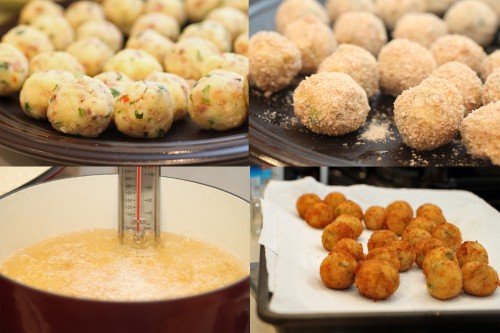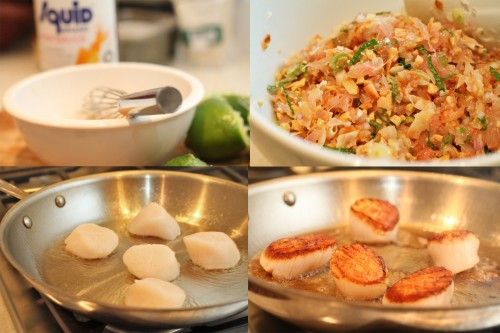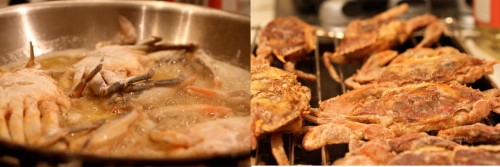FEAST OF THE SEVEN FISHES (ITALIAN AND BEYOND!)
It’s only a few days to Christmas and time to commit to a decision on what to make for your holiday dinner (if you haven't already!). The thought of turkey makes you cringe, with good reason….so what else is there to make? In my house, the go-to for Christmas dinner is always a plump, juicy roast (think standing rib roast or rack of lamb), but this year I am inspired by the ‘Feast of the Seven Fishes’, which is a traditional Italian celebration on Christmas Eve. This meal typically consists of 7 seafood and fish dishes but I've seen some families have upwards of 10! I'm sticking to 3 or 4, thank you. After enduring a 3 day food coma from Thanksgiving, the thought of an array of light seafood dishes for Christmas sounds delicious and not overly filling (not to mention getting a kick start on that New Year's resolution of eating healthy!).
FIRST COURSE: EASY APPETIZER
I like to have a couple simple snacks ready for when guests arrive. Everyone always arrives hungry and ready to eat, and this means they can snack and stay out of the kitchen! ;) Small bites or spreads are best for this feast since there are many more courses to come, so try to keep it simple and easy to make ahead! I love this Peruvian Clams à la Parmesana recipe that's in my cookbook. I learned about these in Lima, clams with a little chili paste, garlic and pisco and then topped with buttery-parmesan breadcrumbs. You can assemble them ahead of time and pop them in when guests arrive - they only take 3 minutes under the broiler! These Quinoa-Crusted Shrimp are another great, healthy option.
SECOND COURSE: RAW BAR OR SEAFOOD SALAD
Photo: Food & Wine
For me, nothing beats a great raw bar to truly showcase the flavors of the sea. Stone crabs, cooked lobster, or gorgeous jumbo shrimp served with a flavorful cocktail or tarator sauce are showstoppers. Pair with a seasonal salad (think: fennel, mache, oranges and pomegranate) with a bit of balsamic and oil.
THIRD COURSE: HEARTY, WHOLE FISH
This course and the next should be the big dishes, the ones that showcase the entire meal. A whole fish, such as red snapper or striped bass would be perfect here with a couple side dishes to go along. A whole fish doesn't have to be daunting, and salt-crusting is the perfect technique! Take 4 cups kosher salt plus 8 egg whites and thoroughly mix together. Make a bed on the baking pan with the salt mixture, lay the fish on top and add a thick coating on top, patting down to seal it all around. Roast for 25 to 30 minutes at 400° F. Crack open the salt layer with a spoon and peel back the skin for the most tender, flavorful (not salty I swear!) fish you've had. Serve with your favorite chili-garlic sauce, chermoula or a lemon-basil vinaigrette.
FOURTH COURSE: PASTA OR, IN MY CASE, PAELLA!
If we were creating a traditional Feast of the Seven Fishes, this course would showcase a pasta dish. But, since the feast is just a guideline to this epic meal, I am choosing to replace the pasta with a delicious seafood paella recipe. The key to a great paella is the rice! You can use short grain rice but if you can find it, bomba rice is what most fine-dining restaurants use and is the traditional rice for this dish. And remember, you want that crunchy rice on the bottom of the pan….that’s the best part!
FIFTH COURSE: SOUP OR SEAFOOD STEW
Photo: Saveur
Yes, can you believe it? We are still eating! If you have room after consuming the previous courses, take it down a notch with a warm brothy seafood or fish soup. This recipe for Ginger Crab is nothing short of amazing and is the type of food I grew up eating - food particular to the East Coast of Africa that blends all that's amazing about African, Indian and Arab foods.
FINALLY: PALATE CLEANSER + DESSERT!
Ok, so I’m combining the last two courses because I just don’t think I can eat anymore at this point! A great palate cleanser could be a simple citrus sorbet or semifreddo. The traditional dessert with this feast is an array of Italian cookies, but since we are skipping the sixth course, I’ve decided to do a decadent South African Cape Malva pudding, a moist, butter-y cake with caramelized edges steeped in a warm brandy sauce. Done!
Enjoy!




























